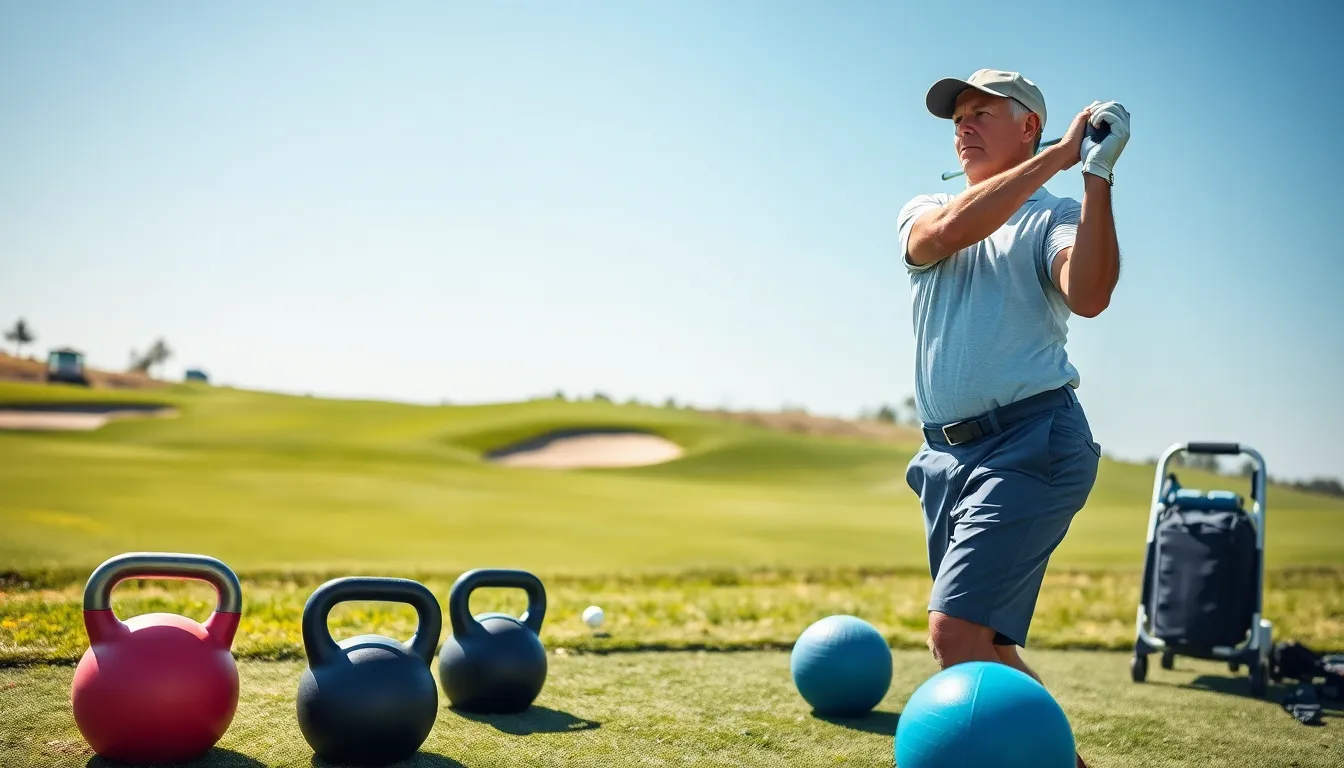Table of Contents
ToggleImagine stepping onto the golf course, feeling as spry as a gazelle and swinging like a pro. Sounds dreamy, huh? Well, it doesn’t have to be an elusive dream. Golf fitness training is the golden ticket to elevating both performance on the greens and longevity in the game. Whether you’re an amateur looking to improve your swing or a seasoned pro who wants to prolong your golf journey, integrating fitness into your routine is not just advisable, it’s essential.
Understanding the Importance of Golf Fitness

Golf isn’t just a leisurely stroll with a stick in hand: it’s a demanding sport that requires a blend of physical abilities and mental acumen. Golf fitness training enhances overall athletic capability, allowing players to achieve their best. A well-structured fitness regime can lead to improved power, flexibility, and endurance, which are crucial for consistent performance.
Also, golfers often face injuries due to repetitive motions and improper body mechanics. By embracing fitness training, one addresses weaknesses, eventually reducing the risk of injury. In golf, longevity isn’t just about years played: it’s about enjoying the game fully, free from the aches and pains that often accompany aging or injury. So, let’s explore how one can transform their fitness approach to golf.
Key Components of Golf Fitness Training
Golf fitness is multifaceted, encapsulating various elements crucial for peak performance.
Exercises for Improved Golf Performance
A golfer’s swing hinges on explosive power and precise coordination. Incorporating exercises like medicine ball throws and kettlebell swings can significantly enhance swing speed. While it may feel a bit strange tossing a ball around like a kid in a playground, these movements will work wonders for muscle engagement and quickness.
Flexibility and Mobility Training
Flexibility isn’t just for yogis. Increased joint mobility holds the secret to a full and effective swing. Dynamic stretching routines enable golfers to achieve optimal torso rotation while minimizing injury risk. Make sure to include movements like torso twists and hip openers: your future self will thank you.
Strength and Endurance Exercises
Golf requires strength, particularly in the legs and back. Engaging in squats and lunges can fortify these areas, preparing the golfer for those long rounds. But endurance is just as vital: integrating circuit training can enhance overall stamina. Who says cardio can’t have a fancy name without involving running miles?
Core Stability and Balance
The core is the powerhouse for stability and control during a swing. Planks, side planks, and rotational exercises contribute immensely to core strength. Balance training, through single-leg exercises, also bolsters stability. And let’s face it, good balance can save one from embarrassing falls on the green.
Creating a Personalized Golf Fitness Plan
Every golfer is unique, and their fitness plans should reflect individual needs and goals. Start by assessing current fitness levels and identifying areas that require improvement. A balanced training regimen combines flexibility, strength, endurance, and stability exercises tailored to one’s needs.
Setting realistic and measurable goals creates a sense of accountability. Whether it’s improving swing speed by a few miles per hour or eliminating back pain, personal goals keep motivation high. A plan that focuses on frequent assessments allows for periodic adjustments to optimize progress. For instance, assessing swing mechanics through video analysis can highlight specific fitness needs.
Nutrition and Recovery for Golfers
One can’t overlook the role of nutrition in a golfer’s fitness journey. Just as fuel is essential for a car, the right food sustains athletic performance. A balanced diet rich in lean proteins, whole grains, and healthy fats supports muscle recovery and energy levels. Staying hydrated is equally vital. Water intake shouldn’t be an afterthought, it’s just as crucial as the swing itself.
Recovery strategies, like stretching or foam rolling post-round, ensure that one stays flexible and prevents stiffness. Also, getting enough sleep revitalizes the body. So, before reaching for that late-night snack, consider how the body needs rest more than chips and dip.
Tracking Progress and Adjusting Your Training
Progress in golf fitness training isn’t always a straight line. Regularly tracking advancements through fitness logs or performance metrics (like swing speeds) keeps one aware of improvements. It’s not just about looking good: it’s about feeling good and hitting those greens with confidence.
Adjusting training regimens based on progress is crucial. If an exercise feels too easy or ineffective, it’s time to mix things up. Periodic evaluations, such as fitness assessments, allow golfers to replace less beneficial exercises with new ones targeting specific skill areas. Adapting to the body’s responses keeps the training fresh and exciting, not to mention effective.



